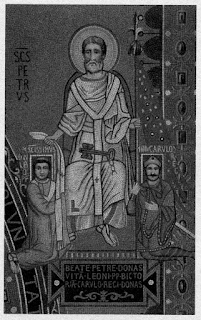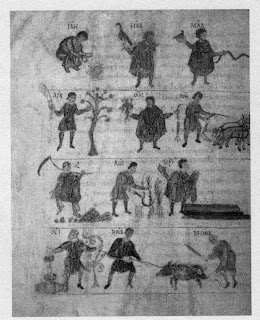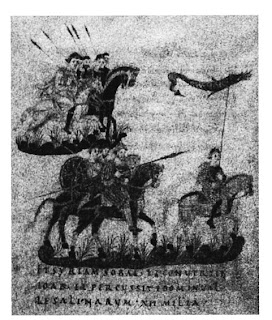kw: book reviews, nonfiction, history, medieval history, empires
After he finished his MA in History, my brother was not admitted to the PhD program, for reasons that sounded ambiguous. A friend in the department told him it was because he was already a popular writer, and his writing style put the faculty's writing to shame.
Fortunately, his work for and with members of the Archaeology department made him welcome there, so he became a Mayan Archaeologist. Equally fortunately, not all historians write badly. Jeff Sypeck of the U. of MD writes very well indeed, and his recent book Becoming Charlemagne: Europe, Baghdad, and the Empires of A.D. 800 is very readable and informative.
 Though I am descended from Charlemagne, I knew little beyond that he was crowned emperor in 800. I thought it had occurred in Aachen, and I didn't know the name of the pope. By the way, nearly everyone of European descent is descended from Charlemagne; I happen to be one who can show it, all 39 generations.
Though I am descended from Charlemagne, I knew little beyond that he was crowned emperor in 800. I thought it had occurred in Aachen, and I didn't know the name of the pope. By the way, nearly everyone of European descent is descended from Charlemagne; I happen to be one who can show it, all 39 generations.
This illustration, from page 139, a mosaic at the Triclineo Leoniano, shows St. Peter blessing Pope Leo III, on the left, and Karl, king of the Franks, on the right. Click on the image for a clearer view. I'll have a further word about the illustrations at the end of this post.
Dr. Sypeck focuses on the four years preceding Karl's imperial coronation by Leo III in Rome, on the coronation, and on the events that followed which eventually produced the "Holy Roman Empire". I found it fascinating to learn of the condition and interactions of the thriving Eastern and crumbled Western Roman empires (centered in Rome and Constantinople), the Abbasid realm of Harun Al-Rashid (the Caliph in the 1001 Nights), and the "new Rome" pretensions of Karl in Aachen. In my opinion, providing this kind of comprehensive view, showing what was really going on, is one major thing that historians are for.
Even in his own day, Karl stood so large that his sons and heirs were mere appendages. His stature assured that they were little remembered by the late 800s. Though Karl intended to be great, he could little imagine the iconic status he has achieved. Dr. Sypeck's excellent synthesis helps us understand how it happened.
One of the jacket blurbs calls the book "An impressive exercise of historical imagination." I think this assessment is more slight than praise. Where the author has had to imaginatively fill in, he makes it clear that he is doing so. This book is a triumph of synthesis, not imagination.
I promised a word on the illustrations. There are about a dozen, and about half are clear and helpful. However, some are obscure at best, due to a lack on the part of the publisher, I believe.
 This image, for example, appears on page 132. It shows a pictorial calendar drafted in Salzburg in 818. It is shown here at about the size it is in the book. After scanning it, I removed the halftone and lightened it. Click on this image to see the cleaned-up scan at full size.
This image, for example, appears on page 132. It shows a pictorial calendar drafted in Salzburg in 818. It is shown here at about the size it is in the book. After scanning it, I removed the halftone and lightened it. Click on this image to see the cleaned-up scan at full size.
The printed image is darker and harder to interpret. It would have been a minor task for the publisher to produce an image that printed better and more clearly, with better contrast.
A little looking on the Internet yielded a website having links to images of the same manuscript in larger sizes. While a color image in the same size would be easier to understand (see below), a rendering of the image with more contrast and a lighter background would be a great improvement.
 The image you'll see when you click on this one is from the German Wikipedia article Monatsbilder . "Monatsbilder" means "daily pictures", and in this case, the article is about pictorial calendars.
The image you'll see when you click on this one is from the German Wikipedia article Monatsbilder . "Monatsbilder" means "daily pictures", and in this case, the article is about pictorial calendars.
The program I use to edit images is IrfanView, which can be found here. I find it does all I need, and its cost is very low. Though you can install it free, I sent the creator $20. Compare that to the cost of PhotoShop!
When I scan a printed photo, I scan it at 400-480 dpi, depending on the pitch of the halftone (typically 100-120 dots/inch). I set the blur factor to 0.99 and blur twice. Then I reduce the image size to a half or a quarter. This removes the halftone dots. Sometimes I sharpen at that point, using a factor of 0.25 at most.
Of course, for this downloaded color scan, there is no halftone to remove, and the archivist has done any sharpening required. The images that follow, from page 199, show even better how increasing contrast and lightness improve an illustration.
The image on the left is as scanned, after halftone removal. On the right, I increased both brightness and contrast, making the image much more clear. Click on either image to see them at the scanned resolution. These problems with some of the illustrations are the only drawbacks to Dr. Sypeck's excellent book.





No comments:
Post a Comment